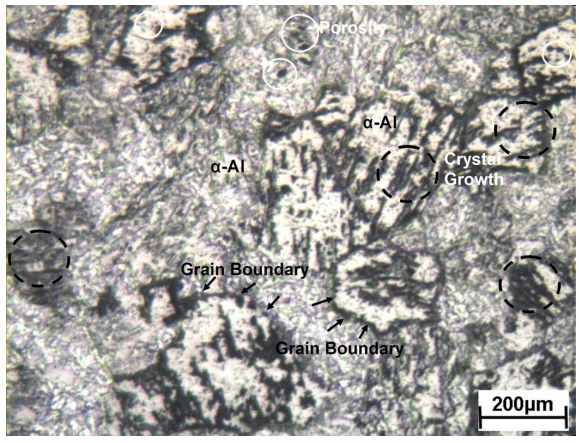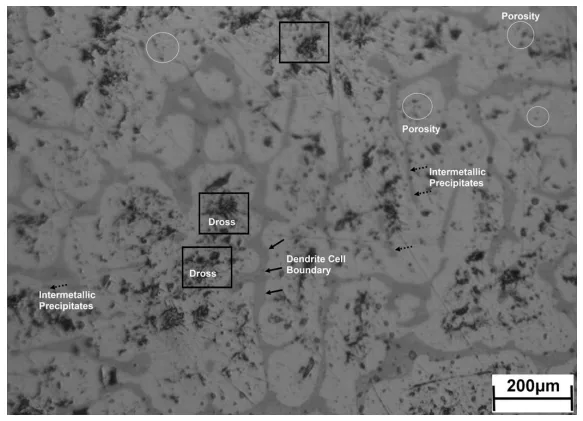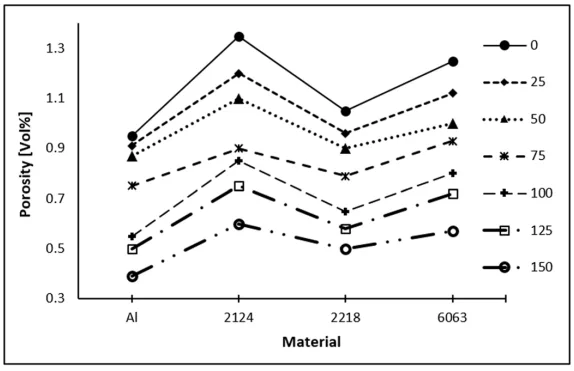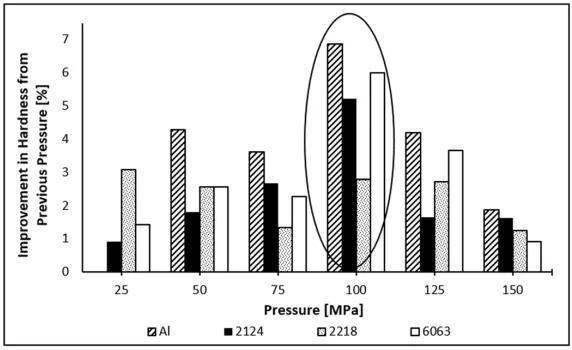How Liquid Forging Pressure Unlocks Superior Hardness and Reduces Porosity in Aluminum Alloys
This technical summary is based on the academic paper "EFFECT OF LIQUID FORGING PRESSURE ON SOLUBILITY AND FREEZING COEFFICIENTS OF CAST ALUMINUM 2124, 2218 AND 6063 ALLOYS" by Vineet Tirth and Amir Arabi, published in Archives of Metallurgy and Materials (2020). It has been analyzed and summarized for technical experts by CASTMAN.
![Fig. 9. Freezing time [s] of materials CP-Al, 2124, 2218, and 6063 prepared at 0, 25, 75, 100, 125 and 150 MPa](https://castman.co.kr/wp-content/uploads/image-3015.webp)
Keywords
- Primary Keyword: Liquid Forging Pressure
- Secondary Keywords: Squeeze Casting, Aluminum Alloys, Porosity Reduction, Mechanical Properties, Solubility Coefficient, Freezing Coefficient, 2124 Alloy, 6063 Alloy
Executive Summary
- The Challenge: To overcome common casting defects like porosity and improve mechanical properties in high-demand aluminum alloys by combining the advantages of casting and forging.
- The Method: Applying a range of liquid forging pressures (0 to 150 MPa) during the solidification of commercially pure aluminum and three common alloys (2124, 2218, 6063) while maintaining constant pouring and mold temperatures.
- The Key Breakthrough: A moderate pressure of 100 MPa provides the most significant improvement in hardness and microstructure refinement, reducing porosity by over 50% and increasing hardness by up to 22.58%.
- The Bottom Line: Optimizing Liquid Forging Pressure is a critical, cost-effective strategy for enhancing the material integrity and mechanical performance of complex aluminum components for the automotive, aerospace, and defense industries.
The Challenge: Why This Research Matters for HPDC Professionals
In high-performance applications, components require both the intricate shapes offered by casting and the superior mechanical properties of forging. Conventional casting methods, however, often struggle with defects like porosity, which can compromise structural integrity. Liquid forging, also known as squeeze casting, was developed to bridge this gap by applying high pressure to molten metal as it solidifies.
While the benefits of this technique are known, the precise relationship between pressure and key material properties like hardness, porosity, and solidification behavior is not always well-defined for specific alloys. This lack of quantitative data makes process optimization difficult, potentially leading to inefficient, energy-intensive operations. This research was undertaken to systematically investigate the effect of Liquid Forging Pressure on four widely used aluminum materials, providing the empirical data needed to design more efficient and reliable manufacturing processes.
The Approach: Unpacking the Methodology
The researchers conducted a comparative study on four materials: commercially pure Aluminum (CP-Al) and three widely used aluminum alloys: 2124, 2218, and 6063.
- Process Parameters: To isolate the effect of pressure, the pouring temperature was fixed at 700°C and the mold temperature at 250°C, based on recommendations from published literature.
- Variable: The direct liquid forging pressure was the primary variable, applied in seven steps: 0 MPa (gravity cast), 25, 50, 75, 100, 125, and 150 MPa.
- Equipment: A vertical semi-automatic hydraulic press was used to apply the pressure.
- Analysis: The resulting samples were rigorously analyzed to determine the impact of pressure. Microstructures were examined using optical and scanning electron microscopy (SEM). Porosity was calculated by carefully measuring material density using the water immersion method. Mechanical properties were evaluated by measuring Vicker's hardness (HV5). Additionally, the study determined the freezing time and melting points to calculate the freezing and solubility coefficients.
The Breakthrough: Key Findings & Data
The study yielded critical insights into how pressure transforms material properties during solidification, establishing clear, data-backed relationships.
Finding 1: Significant Porosity Reduction and Hardness Improvement at 100 MPa
The application of pressure had a dramatic effect on both porosity and hardness. As pressure increased from 0 to 150 MPa, porosity consistently decreased across all materials.
- Porosity Reduction: As shown in the data summarized in Figure 4, the porosity was reduced by 58.94% in CP-Al, 55.55% in 2124, 52.38% in 2218, and 54.4% in 6063. This is because pressure increases the solubility of gases in the melt, preventing the formation and growth of gas bubbles that cause porosity.
- Hardness Increase: Correspondingly, hardness improved significantly. According to Figure 6, the total hardness improvement from 0 to 150 MPa was 22.58% for CP-Al, 12.84% for 2124, 14.53% for 2218, and 17.94% for 6063.
- Optimal Pressure Point: Crucially, the study identified an optimal pressure range. As illustrated in Figure 7, the greatest incremental improvement in hardness for all materials occurred when the pressure was increased from 75 to 100 MPa. This suggests that a moderate pressure of 100 MPa offers a highly effective balance between property enhancement and the energy costs associated with higher pressures.
Finding 2: Predictive Models for Solubility and Freezing Coefficients
A key contribution of this research is the development of mathematical models that predict material behavior under pressure.
- Solubility Coefficient (Ks): The study found that the solubility coefficient—a measure of the melt's ability to dissolve gases—has a complex polynomial relationship with pressure. As seen in Figure 5, Ks first decreases and then increases with pressure. The researchers derived specific polynomial equations (Equations 8-11) for each material, allowing engineers to calculate the required pressure to achieve a desired level of gas solubility (and thus, lower porosity).
- Freezing Coefficient (Kf): The time required for solidification was found to decrease linearly as pressure increased. This is because higher pressure improves thermal contact between the casting and the mold, accelerating heat transfer. The study provides linear equations (Equations 12-15) for each material, enabling the precise calculation of freezing time based on the applied Liquid Forging Pressure.
Practical Implications for R&D and Operations
- For Process Engineers: This study suggests that adjusting pressure to the 100 MPa range may contribute to an optimal balance of improved mechanical properties and energy efficiency. The derived equations for freezing time (Eq. 12-15) and solubility (Eq. 8-11) can be used as a basis for process simulation and optimization, reducing trial-and-error.
- For Quality Control Teams: The data in Figure 4 and Figure 6 of the paper illustrates the strong inverse correlation between porosity and hardness. This suggests that Vicker's hardness testing can serve as a reliable and efficient proxy for assessing the internal soundness and integrity of components produced under varying pressures.
- For Design Engineers: The findings indicate that alloys with a higher volume of intermetallic precipitates (e.g., 2124) may be more prone to retaining porosity at lower pressures. This is a valuable consideration when selecting materials for high-integrity components that will undergo liquid forging or similar high-pressure casting processes.
Paper Details
EFFECT OF LIQUID FORGING PRESSURE ON SOLUBILITY AND FREEZING COEFFICIENTS OF CAST ALUMINUM 2124, 2218 AND 6063 ALLOYS
1. Overview:
- Title: EFFECT OF LIQUID FORGING PRESSURE ON SOLUBILITY AND FREEZING COEFFICIENTS OF CAST ALUMINUM 2124, 2218 AND 6063 ALLOYS
- Author: VINEET TIRTH, AMIR ARABI
- Year of publication: 2020
- Journal/academic society of publication: Arch. Metall. Mater. (Archives of Metallurgy and Materials)
- Keywords: Liquid Forging; Porosity; Hardness; Solubility Coefficient; Freezing Coefficient
2. Abstract:
Liquid forging alias squeeze casting gives the combined advantage of casting and forging. Optimum process parameters are important to get a cost-efficient process. In this study, four materials have been identified, which are extensively used in industries. These materials are commercially pure Al and three Al-alloys namely, 2124, 2218 and 6063. The pouring temperature and the mold temperature is maintained at 700°C and 250°C respectively. The materials were developed at seven pressure variations from 0 to 150 MPa. The effect of the pressure on the microstructures, porosity, and hardness has been reported. The coefficient of solubility is estimated for all materials and a polynomial relationship is found to be the best fit with the applied pressure. The pressure of 100 MPa gives better increment in hardness. The melting point and the freezing coefficient of the materials under study have been determined. A linear relationship between the pressure and the freezing time is deduced. It is observed that the solubility and the freezing coefficients depend on the pressure as well, in addition to the composition and temperature.
3. Introduction:
The introduction explains that liquid forging (LF) unites the advantages of casting (intricate form, good surface finish) and forging (superior properties). It offers a high casting yield (>90%) and produces components that can undergo secondary processes like heat treatment. The technique was developed to fill the gap between pressure die casting, gravity casting, and forging. The paper notes that while LF has been used since the 1960s, further research is needed to optimize process parameters for specific alloys to ensure cost efficiency.
4. Summary of the study:
Background of the research topic:
Liquid forging is a hybrid manufacturing process that applies high pressure during the solidification of molten metal in a die. This pressure helps minimize defects like porosity, refines the microstructure, and improves mechanical properties.
Status of previous research:
Previous studies have established that pressure refines grain size, reduces dendrite arm spacing, increases heat transfer, and improves properties like tensile strength and hardness. Research has shown that moderate pressures (e.g., 100-140 MPa) can produce sound properties in alloys like 2024 and A380. However, a direct comparative study on the specific effects of pressure on the solubility and freezing coefficients for CP-Al, 2124, 2218, and 6063 alloys has not been reported.
Purpose of the study:
The study aims to conduct a comparative analysis of the effect of liquid forging pressure on commercially pure aluminum and three popular alloys (2124, 2218, 6063). The primary goals are to quantify the relationship between pressure and key characteristics like porosity, hardness, solubility coefficient (Ks), and freezing coefficient (Kf), and to identify optimal process parameters for cost efficiency.
Core study:
The core of the study involved fabricating samples of the four materials at seven different pressures (0 to 150 MPa) while keeping other parameters constant. The resulting samples were then analyzed to measure changes in microstructure, porosity, and hardness. Based on these measurements and thermal analysis, the study derived mathematical equations to model the relationship between pressure and the solubility and freezing coefficients.
5. Research Methodology
Research Design:
The study employed an experimental research design. A single variable, applied pressure, was systematically varied across seven levels. All other key parameters, such as pouring temperature (700°C) and mold temperature (250°C), were held constant to isolate the effect of pressure. Four different materials were tested under these conditions for a comparative analysis.
Data Collection and Analysis Methods:
- Material Preparation: Materials were prepared using standard melting practices and cast into permanent steel molds using a direct liquid forging method on a semi-automatic hydraulic press.
- Microstructural Analysis: Samples were etched with dilute Hydrofluoric acid and examined using an Olympus-PME3 optical microscope and a Jeol JSM-6390 LV Scanning Electron Microscope (SEM).
- Porosity Measurement: Density was determined using the water immersion method (ASTM C 135-96). Porosity was then calculated using Equation (2), which compares the measured density to the theoretical density based on the material's composition.
- Hardness Testing: Vicker's hardness was measured using a 5 kg load applied for 10 s, as per ASTM E92.
- Thermal Analysis: Melting points were determined by recording time-temperature data in a resistance furnace. Freezing time was measured with a stopwatch from the point of piston contact until movement ceased.
Research Topics and Scope:
The research focuses on the effect of liquid forging pressure on four specific aluminum-based materials: CP-Al, 2124, 2218, and 6063. The scope is limited to a pressure range of 0-150 MPa, a pouring temperature of 700°C, and a mold temperature of 250°C. The study investigates microstructure, porosity, hardness, and derives the solubility and freezing coefficients.
6. Key Results:
Key Results:
- Increasing pressure from 0 to 150 MPa significantly reduces porosity in all materials, with reductions ranging from 52.38% to 58.94%.
- Hardness increases with pressure for all materials, with improvements ranging from 12.84% to 22.58%.
- The most significant incremental gain in hardness occurs when pressure is increased from 75 MPa to 100 MPa.
- A polynomial relationship exists between the solubility coefficient (Ks) and applied pressure, with predictive equations derived for each material.
- A linear relationship exists between freezing time and applied pressure, with higher pressure leading to shorter freezing times due to enhanced heat transfer.
Figure Name List:
- Fig. 1. Comparative study of Liquid Forging and other methods based on the effectiveness on a scale 0-100
- Fig. 2(a). Optical micrographs (etched) of CP-Al prepared at 100 MPa
- Fig. 2(b). Optical micrographs (etched) of 2124 prepared at 100 MPa
- Fig. 2(c). Optical micrographs (etched) of 2218 prepared at 100 MPa
- Fig. 2(d). Optical micrographs (etched) of 6063 prepared at 100 MPa
- Fig. 3(a). SEM pictures of CP-Al prepared at 100 MPa
- Fig. 3(b). SEM pictures of 2124 prepared at 100 MPa
- Fig. 3(c). SEM pictures of 2218 prepared at 100 MPa
- Fig. 3(d). SEM pictures of 6063 prepared at 100 MPa
- Fig. 4. The porosity in materials CP-Al, 2124, 2218, and 6063 prepared at 0, 25, 75, 100, 125 and 150 MPa
- Fig. 5. Coefficient Ks in materials CP-Al, 2124, 2218, and 6063 prepared at 0, 25, 75, 100, 125 and 150 MPa
- Fig. 6. Hardness [HV5] of materials Al, 2124, 2218, and 6063 prepared at 0, 25, 75, 100, 125 and 150 MPa. The digit in % indicates improvement in hardness from its value at 0 MPa
- Fig. 7. Improvement in hardness (%) from the preceding pressure
- Fig. 8(a). Time-Temperature diagram of the muffle and the materials
- Fig. 8(b). Time-Temperature diagram enlarged, reflecting the melting of materials
- Fig. 9. Freezing time [s] of materials CP-Al, 2124, 2218, and 6063 prepared at 0, 25, 75, 100, 125 and 150 MPa
- Fig. 10. Coefficient Kf of materials Al, 2124, 2218, and 6063 prepared at 0, 25, 75, 100, 125 and 150 MPa. The digits show the average value of Kf for a material




7. Conclusion:
The study successfully demonstrated that liquid forging pressure is a critical parameter for refining the microstructure and improving the properties of CP-Al, 2124, 2218, and 6063 alloys. A moderate pressure of 100 MPa provides a refined microstructure with limited porosity. Porosity consistently decreases with increasing pressure, with CP-Al showing the best response. The solubility coefficient (Ks) was found to have a complex polynomial dependence on pressure, while the freezing coefficient (Kf) and freezing time have a linear relationship. The hardness improves for all materials, with the best percent improvement occurring at 100 MPa. The derived relationships and average coefficient values provide valuable tools for engineers to estimate required parameters for Al alloys.
8. References:
- [1] S.N. Chou, J.L. Huang, D.F. Lii, H.H. Lu, J. Alloys Compd. 419, 98 (2006).
- [2] M. Dhanashekar, V.S.S. Kumar, Procedia Eng. 97, 412 (2014).
- [3] M.T. Abou EI-Khair, Mater. Lett. 59, 894 (2005).
- [4] X. Fang, S. Lü, L. Zhao, J. Wang, L. Liu, S. Wu, Mater. Design. 94, 353 (2016).
- [5] C.G. Kang, K.S. Yun, Fabrication of metal-matrix composite by the die-casting technique and the evaluation of their mechanical properties, J. Mater. Process Tech. 62, 116 (1996).
- [6] Y. Liu, Z. Zheng, C. Yang, D. Zhu, W. Chen, Tribol. Lett. 65, 39 (2017).
- [7] V. Tirth, J. Tribol. 140, 1 (2018).
- [8] V. Tirth, S. Ray, M.L. Kapoor, Metall. Mater. Trans. A Phys. Metall. Mater. Sci. 40, 1246 (2009).
- [9] V. Tirth, A. Algahtani, E.R.I. Mahmoud, Mater. Express. 8 (6), 475 (2018).
- [10] V. Tirth, A. Algahtani, A. Edacherian, Mater. Express. 8 (6), 531 (2018).
- [11] A. Jahangiria, S.P.H. Marashi, M. Mohammadaliha, V. Ashofte, J. Mater. Process Tech. 245, 1 (2017).
- [12] P.G.C. Manjunath, A. Kumar, M.B. Parappagoudar, J. Manuf. Process. 32, 199 (2018).
- [13] Y. Wang, S. Zhao, C. Zhang, Trans. Nonferrous Met. Soc. China, 28 (2), 235 (2018).
- [14] L. Natrayan, M.S. Kumar, K. Palanikumar, Mater. Res. Express 5, 1(2018).
- [15] Q. Zhao, Y. Wu, W. Rong, K. Wang, L. Yuan, X. Heng, J. Magnes. Alloy. 6 (2), 197 (2018).
- [16] F. Wang, W. Meng, H. Zhang, Z. Han, Trans. Nonferrous Met. Soc. China. 28 (10), 1920 (2018).
- [17] Y. Zou. Phase equilibria and solidification of Al rich Al-Cu-Mg alloys. In: PhD Thesis. University of Wisconsin, Madison USA, 1997.
- [18] T.M. Yue, G.A. Chadwick, Jr. of Mat. Proc. Tech. 58, 302 (1996).
- [19] R. Pastircak, J. Scury, Arch. Metall. Mater. 62 (4), 2193 (2017).
- [20] M. Lagiewka, Arch. Metall. Mater. 59 (2), 707 (2014).
- [21] F. Hnilica, V. Ocenasek, I. Stulikova, B. Smola, Kovove Mater. 43, 300 (2005).
- [22] K. Solek, P. Kapranos, Arch. Metall. Mater. 61 (4), 1901 (2016).
- [23] K. Solek, S. Szczepanik, Arch. Metall. Mater. 60 (4), 2613 (2015).
- [24] S.N. Kulkarni, D.K. Radhakrishna, Mater Sci-Poland. 29 (2), 135 (2011).
- [25] H. Murat Lus, Kovove Mater. 50, 243 (2012).
- [26] H. Barhoumi, S. Souissi, M. ben Amar, F. Elhalouani, Kovove Mater. 54, 249 (2016).
- [27] W.G. Wang, K.C. Chang, K. Matsugi, G. Sasaki, Mater. Trans. 49 (3), 637 (2008).
- [28] L. Hao, X. Yang, S. Lu, X. Fang, S. Wu, Materials Science & Engineering A. 707, 280 (2017).
- [29] D.H. Chen, Z. Chen, X.R. Zhu, Y.Y. Wu, Z.M. Guo, H.X. Shi, Rare. Metal. Mat. Eng. 46 (11), 3525 (2017).
- [30] A. Klasik, M. Maj, K. Pietrzak, A. Wojciechowski, J. Sobczak, Arch. Metall. Mater. 61 (4), 2123 (2016).
- [31] S. Li, K. Mine, S. Sanakanishi, K. Anzai, Mater. Trans. 48 (8), 2186 (2007).
- [32] S. Venkatesana, M.A. Xaviorb, Materials Today: Proceedings 5, 11175 (2018).
- [33] B. Sh, X. Sh, L. Tian, N. Zhao, L. Li, Trans. Nonferr. Met. Soc. China 97, 412 (2013).
- [34] J. Singh, S.K. Goel, V.N.S. Mathur, M.L. Kapoor, AFS Transaction 99, 815 (1991).
- [35] http://www.matweb.com/search/datasheet.aspx?bassnum=AMEAL00
- [36] http://www.matweb.com/search/datasheet.aspx?matguid=19ddeefbcbb74c0aa557e4cfcfcb0797
- [37] http://www.matweb.com/search/datasheet.aspx?matguid=47278d3d797941699c7e73f1cd890317
- [38] http://asm.matweb.com/search/SpecificMaterial.asp?bassnum=MA6063T6
Expert Q&A: Your Top Questions Answered
Q1: Why were the pouring and mold temperatures fixed at 700°C and 250°C for this study?
A1: The researchers selected these temperatures based on a review of existing literature and their own pilot studies. As stated in Section 3.3, these specific temperatures were chosen to effectively limit porosity and achieve a refined microstructure. By keeping these thermal parameters constant, the study could accurately isolate and quantify the specific effects of varying the Liquid Forging Pressure.
Q2: The study highlights 100 MPa as an effective pressure. Why is applying even higher pressure, like 150 MPa, not necessarily better?
A2: While properties like hardness continue to improve slightly up to 150 MPa, the rate of improvement diminishes. Figure 7 clearly shows the largest jump in hardness occurs between 75 and 100 MPa. The paper also notes that higher pressures lead to a more "costly and energy-intensive process." Therefore, 100 MPa represents a point of optimal return, providing substantial material property gains without the excessive energy consumption of higher pressures.
Q3: Can you explain the unusual behavior of the solubility coefficient (Ks) in Figure 5, where it first decreases and then increases with pressure?
A3: The paper attributes this complex trend to the "combined effect of cooling, pressure, and the refinement of microstructure." During freezing under pressure, the composition of the alloy changes due to the precipitation of new phases. This compositional change, combined with the direct effect of pressure on gas solubility and the evolving microstructure, results in the observed non-linear, polynomial behavior of the Ks value.
Q4: Why did Commercially Pure Aluminum (CP-Al) show a greater percentage improvement in hardness (22.58%) than the more complex alloys?
A4: As explained in Section 3.3, the alloys (2124, 2218, 6063) already possess a higher base hardness due to the presence of alloying elements and strengthening precipitates. CP-Al, being a softer material initially, has more potential for work hardening and grain refinement from the applied pressure. Therefore, while the final hardness of the alloys is higher, the relative improvement from the pressure application is more pronounced in the pure aluminum.
Q5: The study reports that CP-Al had the best response in terms of porosity reduction. What is the reason for this?
A5: The paper concludes that the presence of precipitates in the alloys hinders the dissolution or diffusion of gas bubbles. In CP-Al, which lacks these precipitates, the gas bubbles can dissolve more easily into the melt under pressure, leading to a more effective reduction in porosity compared to the alloys, where precipitates can act as sites for pores to be retained.
Conclusion: Paving the Way for Higher Quality and Productivity
This research provides a clear and actionable framework for understanding the critical role of Liquid Forging Pressure in manufacturing high-integrity aluminum components. By systematically quantifying the link between pressure, porosity, and hardness, the study confirms that a moderate pressure of 100 MPa is a powerful tool for refining microstructure and enhancing mechanical properties. The predictive equations developed for solubility and freezing coefficients offer engineers the data needed to move from empirical trial-and-error to model-based process design, saving time and energy.
At CASTMAN, we are committed to applying the latest industry research to help our customers achieve higher productivity and quality. If the challenges discussed in this paper align with your operational goals, contact our engineering team to explore how these principles can be implemented in your components.
Copyright Information
- This content is a summary and analysis based on the paper "EFFECT OF LIQUID FORGING PRESSURE ON SOLUBILITY AND FREEZING COEFFICIENTS OF CAST ALUMINUM 2124, 2218 AND 6063 ALLOYS" by "VINEET TIRTH and AMIR ARABI".
- Source: https://doi.org/10.24425/amm.2020.131738
This material is for informational purposes only. Unauthorized commercial use is prohibited.
Copyright © 2025 CASTMAN. All rights reserved.